 W
WThe Eurasian nuthatch is a small passerine bird found throughout temperate Asia and in Europe. There are more than 20 subspecies, but the precise number depends on how small differences between populations are evaluated. This article follows the 2013 Handbook of the Birds of the World Alive treatment, which has more recognised forms than the 1996 Tits, Nuthatches and Treecreepers. Given the similarities between geographical forms of the Eurasian nuthatch, subspecies boundaries are somewhat fluid, although fewer than half as many are recognised now as in 1967.
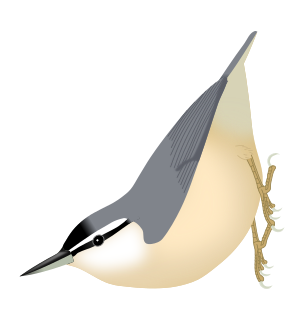 W
WThe Algerian nuthatch is a small passerine bird which is the only bird species endemic to Algeria, where it is also the only nuthatch. It was first discovered on October 5, 1975, at the Djebel Babor in the Petite Kabylie range in northern Algeria, by a team led by a young Belgian agronomist Jean-Pierre Ledant.
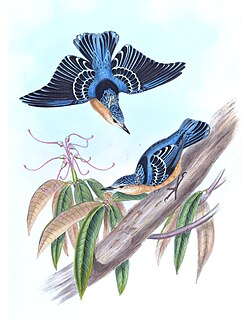 W
WThe beautiful nuthatch is a bird species in the family Sittidae, collectively known as nuthatches. It is a large nuthatch, measuring 16.5 cm (6.5 in) in length, that is not sexually dimorphic. Its coloration and markings are dramatic, the upper parts being black and azure, streaked with white and pale blue on the head and lined with the same colors on the wing feathers. The underparts are orange, and the eyebrow and throat are ochre. An irregular, dark eyestripe highlights its eye. S. formosa's ecology is not fully described, but it is known to feed on small insects and larvae found on the trunks and epiphyte-covered branches of trees in its range. Reproduction takes place from April to May; the nest is placed in the hole of an oak, rhododendron, or other large tree. The nest is made of plant material and fur in which the bird typically lays four to six eggs.
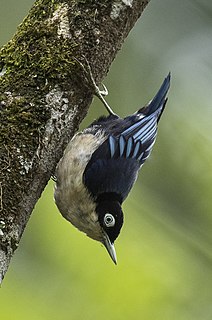 W
WThe blue nuthatch is a bird species in the family Sittidae, collectively known as nuthatches. It is a medium-sized nuthatch, measuring 13.5 cm (5.3 in) in length. The species, which lacks sexual dimorphism, has dramatic coloration unlike any other member of its genus. Its head is black or blackish-blue dark blue upper parts close to purple with azure feathers. The wings are edged with black. The throat and chest are white or a washed buff color, contrasting with the upper and the belly of a very dark blue; the feathers are generally clear, blue-gray or purplish.
 W
WThe brown-headed nuthatch is a small songbird found in pine forests throughout the Southeastern United States. Genetic analyses indicated low differentiation between northern and southern populations in Florida. A population on the Bahamas showed moderate to high differentiation compared with Florida populations. The Bahama nuthatch was and still is considered a subspecies by several authorities including the IOC, but the IUCN and BirdLife International have reclassified it as its own separate species. The bird, like other nuthatches, possesses a sharp black nail-like beak, which it uses to pound open seeds. It is a frequent visitor to feeding stations and is highly fond of sunflower seeds and suet cakes.
 W
WThe Burmese nuthatch also known as the neglected nuthatch is a species of bird in the family Sittidae. It is found in Myanmar, Thailand, Laos, Cambodia, and Vietnam.
 W
WThe chestnut-bellied nuthatch belongs to the family Sittidae.
 W
WThe chestnut-vented nuthatch is a species of bird in the nuthatch family.
 W
WThe Chinese nuthatch or snowy-browed nuthatch, is a species of bird in the family Sittidae. It is found in the Russian Far East, China, North Korea, and South Korea.
 W
WThe Corsican nuthatch is a small passerine bird that is endemic to Corsica, where it is the only nuthatch. It is restricted to mature stands of Corsican pine which grow at altitudes of from 800 to 1,600 m.
 W
WThe Persian nuthatch or the eastern rock-nuthatch is a species of bird in the family Sittidae. It is found in Afghanistan, Armenia, Azerbaijan, Georgia, India, Iran, Iraq, Kazakhstan, Pakistan, Russia, Tajikistan, Turkey, and Turkmenistan.
 W
WThe Eurasian nuthatch or wood nuthatch is a small passerine bird found throughout the Palearctic and in Europe, where its name is the nuthatch. Like other nuthatches, it is a short-tailed bird with a long bill, blue-grey upperparts and a black eye-stripe. It is a vocal bird with a repeated loud dwip call. There are more than 20 subspecies in three main groups; birds in the west of the range have orange-buff underparts and a white throat, those in Russia have whitish underparts, and those in the east have a similar appearance to European birds, but lack the white throat.
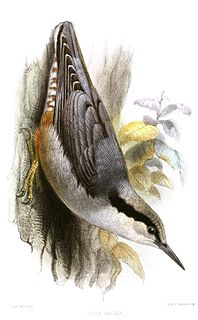 W
WThe giant nuthatch is a species of bird in the family Sittidae. It is the largest species in the genus at 19.5 centimetres (7.68 in), and is largely grey in colour except for a faintly rufous underpart in the female, whose eyestripe is also duller than the male. The bill is much bulkier than other Sitta.
 W
WThe Indian nuthatch is a species of bird in the family Sittidae. It is found in Bangladesh, India and Nepal.
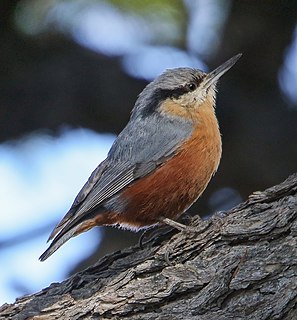 W
WThe Kashmir nuthatch is a species of bird in the family Sittidae. It is found in the northernmost regions of the Indian subcontinent, primarily in the mid-altitudes of the Himalayas. The species ranges across Afghanistan, India, Nepal and Pakistan. The global population size has not been quantified, but the species is described as common in eastern Afghanistan and north-western India, and fairly common in Nepal.
 W
WKrüper's nuthatch is a small nuthatch. The name commemorates the German naturalist Theodor Johannes Krüper.
 W
WThe nuthatches constitute a genus, Sitta, of small passerine birds belonging to the family Sittidae. Characterised by large heads, short tails, and powerful bills and feet, nuthatches advertise their territory using loud, simple songs. Most species exhibit grey or bluish upperparts and a black eye stripe.
 W
WPrzevalski's nuthatch, originally given the nomen nudum "Sitta eckloni", is a bird species in the family Sittidae, collectively known as nuthatches. Long regarded as a subspecies of the white-cheeked nuthatch, it nevertheless differs significantly in morphology and vocalizations. Both S. przewalskii and S. leucopsis have been regarded as closely related to the North American white-breasted nuthatch. It is a medium-sized nuthatch, measuring about 13 cm (5 in) in length. Its upper body is a dark gray-blue or slate color, becoming dark blue-black at the crown. The cheeks and throat are a white buff-orange, turning to a rich cinnamon on the underparts that intensifies in color on the sides of the breast. Vocalizations consist of alternating series of ascending whistles and short notes.
 W
WThe pygmy nuthatch is a tiny songbird, about 10 cm (4 inches) long and about 10 grams in weight.
 W
WThe red-breasted nuthatch is a small songbird. The adult has blue-grey upperparts with cinnamon underparts, a white throat and face with a black stripe through the eyes, a straight grey bill and a black crown. Its call, which has been likened to a tin trumpet, is high-pitched and nasal. It breeds in coniferous forests across Canada, Alaska and the northeastern and western United States. Though often a permanent resident, it regularly irrupts further south if its food supply fails. There are records of vagrants occurring as far south as the Gulf Coast and northern Mexico. It forages on the trunks and large branches of trees, often descending head first, sometimes catching insects in flight. It eats mainly insects and seeds, especially from conifers. It excavates its nest in dead wood, often close to the ground, smearing the entrance with pitch.
 W
WThe Siberian nuthatch is a small passerine bird of the family Sittidae, found in Eastern Siberia. Until 2006, it was usually treated as a subspecies of the Eurasian nuthatch. The split was accepted by the British Ornithologists' Union in 2012.
 W
WThe sulphur-billed nuthatch is a species of bird in the family Sittidae. It is endemic to the Philippines. Its natural habitats are subtropical or tropical moist lowland forest and subtropical or tropical moist montane forest.
 W
WThe velvet-fronted nuthatch is a small passerine bird in the nuthatch family Sittidae found in southern Asia from Nepal, India, Sri Lanka and Bangladesh east to south China and Indonesia. Like other nuthatches, it feeds on insects in the bark of trees, foraging on the trunks and branches and their strongly clawed toes allow them to climb down tree trunks or move on the undersides of horizontal branches. They are found in forests with good tree cover and are often found along with other species in mixed-species foraging flocks. Adult males can be told apart by the black stripe that runs behind and above the eyes. They have a rapid chipping call note. They breed in tree cavities and holes, often created by woodpeckers or barbets.
 W
WThe western rock nuthatch is a small passerine bird which breeds from Croatia east through Greece and Turkey to Iran. This nuthatch is largely resident apart from some post-breeding dispersal. The eastern rock nuthatch Sitta tephronota is a separate species, which occurs further east in south-central Asia.
 W
WThe white-breasted nuthatch is a small songbird of the nuthatch family common across much of temperate North America. It is stocky, with a large head, short tail, powerful bill, and strong feet. It has a black cap, white face, chest, and flanks, blue-gray upperparts, and a chestnut lower belly. Its nine subspecies differ mainly in the color of the body plumage.
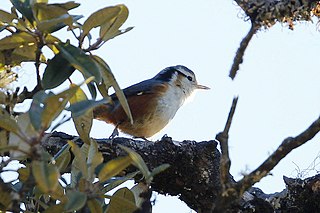 W
WThe white-browed nuthatch is a species of bird in the nuthatch family. It is endemic to Myanmar. Its natural habitat is subtropical or tropical moist montane forests.
 W
WThe white-cheeked nuthatch is a species of bird in the family Sittidae. It is found in Afghanistan, Bhutan, India, Nepal, and Pakistan.
 W
WThe white-tailed nuthatch is a species of bird in the family Sittidae. It ranges across the northern and northeastern parts of the Indian Subcontinent, existing mainly in the low-to-middle Himalayas, as well as associated mountain ranges. It is found in Bhutan, India, Laos, Myanmar, Nepal, Tibet and Thailand.
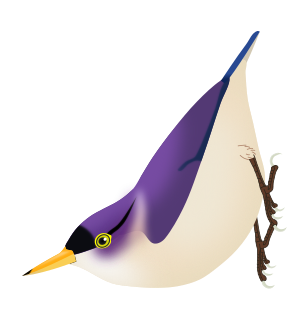 W
WThe yellow-billed nuthatch is a species of bird in the family Sittidae. It is found in Hainan, Laos, and Vietnam.
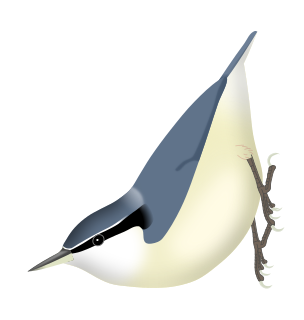 W
WThe Yunnan nuthatch is a species of nuthatch endemic to South-Western China. It was first described by William Robert Ogilvie-Grant in 1900 based on a male holotype, and it occurs in pine forests at altitudes of up to 4,000 m (13,000 ft). It is a small nuthatch, measuring 12 cm in length, without pronounced sexual dimorphism. The upperparts are gray-blue, contrasting with the light, smooth, buffy lowerparts. It has a fine white eyebrow, distinct when the plumage is fresh, and surmounting a pronounced black eye line. It is a noisy bird, producing simple, nasal sounds, sometimes in repetitive series.